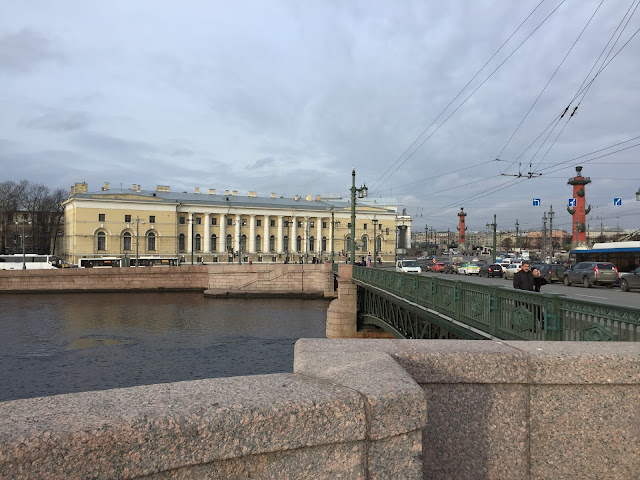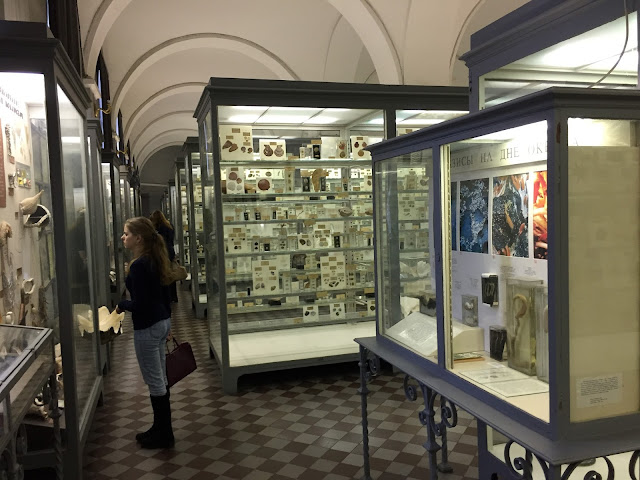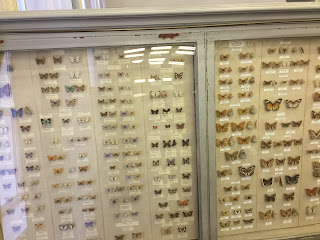190. Zoological Museum of the Russian Academy of Sciences
The Zoological Museum in St Petersburg is affiliated with the Zoological Institute of the Russian Academy of Sciences. I was unaware of its existence for most of my time in St. Petersburg, even though it has a prominent location on Vasilyevsky Island sandwiched in between the Kunstkamera and the Old Stock Exchange building that overlooks the spit of Vasilyevsky Island and the Rostral Columns. I simply never saw anyone going inside and none of my friends or colleagues recommended it, but it turned out to be packed full of visitors when I was there in the middle of November (mostly families with young children, as is typical with natural history museums).
The museum began in the early eighteenth century with the zoological collections of the Kunstkamera. It became a division of the Russian Academy of Sciences in 1724 and was opened to the public in 1838. It has occupied its current home since 1898. The museum's collection of 17 million objects is one of the largest of its kind in the world. Just three percent of this amount (500,000 objects) is on display, and I'm guessing that items are rarely rotated in and out of storage. The vast majority of specimens are taxidermy mounts of mammals, birds, and fishes, which are grouped taxonomically in glass cases. This museum does not have any dinosaurs or fossil animals - it focuses exclusively on the zoology of extant (or recently extinct) groups.
The exhibits generally have the appearance of dating back to the early twentieth century; there are no videos or interactive computer displays here. My first impression was that there are relatively few dioramas, either (my favorite exhibit technique in this type of museum), but that is not quite true. It's just that most of the dioramas are located in free-standing display cases rather than built into the wall, as is common in most other natural history museums. I've always enjoyed natural history museums (I worked in them for five or six years in an earlier career), so I took quite a few pictures of the many unique specimens and dioramas. I've captioned the highlights below, and the remainder are presented without comment to make it clear just how extensive the collections here really are.
The layout of the museum's three halls (which does not quite capture how big the museum is):
The gigantic blue whale skeleton:
A view of the Rostral Column across the street:
***
I believe this is the bird that is represented in the double-headed eagle used in a variety of Russian symbols and coat of arms over the last five centuries:
***
I particularly enjoyed this exhibit on human parasites:
***
This is the museum's most famous specimen, the world's only whole stuffed adult mammoth (excavated in the Russian Far East in 1901 and brought to St. Petersburg for display in 1903):
***
The Zoological Museum's insect collections:
Views of the first hall from the second level:
This is not the only museum in St. Petersburg that has an exit that puts you out into an alley, and makes you question whether you took a wrong turn along the way:
The museum began in the early eighteenth century with the zoological collections of the Kunstkamera. It became a division of the Russian Academy of Sciences in 1724 and was opened to the public in 1838. It has occupied its current home since 1898. The museum's collection of 17 million objects is one of the largest of its kind in the world. Just three percent of this amount (500,000 objects) is on display, and I'm guessing that items are rarely rotated in and out of storage. The vast majority of specimens are taxidermy mounts of mammals, birds, and fishes, which are grouped taxonomically in glass cases. This museum does not have any dinosaurs or fossil animals - it focuses exclusively on the zoology of extant (or recently extinct) groups.
The exhibits generally have the appearance of dating back to the early twentieth century; there are no videos or interactive computer displays here. My first impression was that there are relatively few dioramas, either (my favorite exhibit technique in this type of museum), but that is not quite true. It's just that most of the dioramas are located in free-standing display cases rather than built into the wall, as is common in most other natural history museums. I've always enjoyed natural history museums (I worked in them for five or six years in an earlier career), so I took quite a few pictures of the many unique specimens and dioramas. I've captioned the highlights below, and the remainder are presented without comment to make it clear just how extensive the collections here really are.
The layout of the museum's three halls (which does not quite capture how big the museum is):
The gigantic blue whale skeleton:
A view of the Rostral Column across the street:
***
I believe this is the bird that is represented in the double-headed eagle used in a variety of Russian symbols and coat of arms over the last five centuries:
***
I particularly enjoyed this exhibit on human parasites:
***
This is the museum's most famous specimen, the world's only whole stuffed adult mammoth (excavated in the Russian Far East in 1901 and brought to St. Petersburg for display in 1903):
***
The Zoological Museum's insect collections:
Views of the first hall from the second level:
Some of the initial taxidermy specimens from the Kunstkamera's zoological collections:
This is not the only museum in St. Petersburg that has an exit that puts you out into an alley, and makes you question whether you took a wrong turn along the way:



























































































































































































Comments
Post a Comment